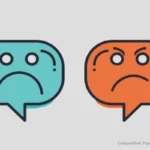
“Better a spanking in time, than regret it all your life.” This phrase and its thousand variants are still very present in the popular imagination. In fact, they are often “given away” as advice to parents to correct their children’s misbehavior. Other times it is used by the adults themselves to justify the physical punishment of children.
Of course, educating is not an easy task. Children do not come with an instruction manual under their arms, and even the staunchest followers of positive discipline and the most quiet parents can lose patience. Unicef confirms it: approximately 80% of parents around the world have spanked their children.
As a rule, we scold our children out of the best of intentions. We want to correct their bad behavior. We want to avoid present or future problems… But other times we also do it simply because we are too tired, stressed, overtaken by circumstances or downright desperate.
All these emotions come together in a kind of explosive cocktail that makes us opt for a spanking or a slap to end a behavior that we do not like. But is it really the solution? Can it avoid greater evils?
The unsuspected consequences of physical punishment in children
Several generations have grown up with the motto “A slap in time doesn’t hurt anyone”. Of course, spanking will not make a child need therapy when he grows up. However, it must be taken into account that physical punishment, especially when repeated, can leave traces, more in the spirit than in the body.
Psychologists from the University of Texas analyzed 50 years of research on the effects of spanking. During that time, more than 160,000 children and the effects of physical punishment were evaluated. These researchers found that the majority of parents who use physical punishment are not fully aware of the consequences of that behavior and obviously do not intend to harm their children’s lives.
Despite this, spanking can have a negative effect in the short and long term. Children who were spanked were more likely to exhibit antisocial behavior and have mental health problems. They could also be more violent, have cognitive and emotional difficulties, as well as have less gray matter in certain areas of the brain.
In addition, they were more likely to use this type of punishment with their own children, perpetuating a culture of physical punishment generation after generation. In fact, we must remember that, as parents, we are our children’s role models, the compass that indicates the difference between good and bad.
When a child is repeatedly physically punished, he will learn that violence is a valid way to resolve problems and is less likely to resort to dialogue to resolve conflicts in the future. This is how parents teach to solve things with blows and not by talking
Furthermore, when little ones resign themselves to accepting painful experiences, especially from people who should protect them, they can become submissive adults who establish relationships of emotional dependency and may be more prone to being manipulated.
Spanking is not didactic or healthy nor does having received it give you permission to give it
There is no “didactic or healthy spanking”. Physical punishment is not educational. It does not generate respect, it engenders fear. It creates awe, but it does not teach reasoning. Of course, the child will stop the negative behavior, but it is likely that he will repeat it again in the future because we have not reflected on the consequences of it and, above all, we have not provided him with a more positive alternative behavior.
A spank won’t tell a child how to fix what he did wrong, but it can limit him and his independence. It is likely that he does not dare to do some things for fear of making a mistake and getting hit again. Unconsciously, parents convey the message that it is wrong for them to make decisions. Therefore, if it is already an indecisive and insecure child, these personality characteristics will be further reinforced.
In fact, physical punishment can also push children to lie to hide their actions. As a result, it ends up creating a wall of misunderstanding with the parents. It generates estrangement and grudges as they grow.
In short, a slap – whether on time or at the wrong time – does not solve any problem. It does not educate or discipline. The fact that you have been educated like this does not justify that you do it too, especially considering that there are much more respectful methods of parenting.
If we have “turned out well” it is usually “despite” having received those slaps and not “thanks” to the spanking.
The alternative to permissiveness is not violence. We can establish rules and limits appropriate to the age and evolutionary moment of our children without resorting to physical punishment. Firmly, but with love. If we do not have the right to exercise any type of violence against another person, we also do not have the right to hit our children. There are other alternatives to avoid they get “lost”.
Sources:
Gershoff, E. T. & Grogan-Kaylor, A. (2016) Spanking and child outcomes: Old controversies and new meta-analyses. J Fam Psychol; 30(4): 453-469.
Taylor, C. A. et. Al. (2010) Use of spanking for 3-year-old children and associated intimate partner aggression or violence. Pediatrics; 126(3): 415-424.
Tomoda, A. et. Al. (2009) Reduced Prefrontal Cortical Gray Matter Volume in Young Adults Exposed to Harsh Corporal Punishment. Neuroimage; 47(2) 66-71.



